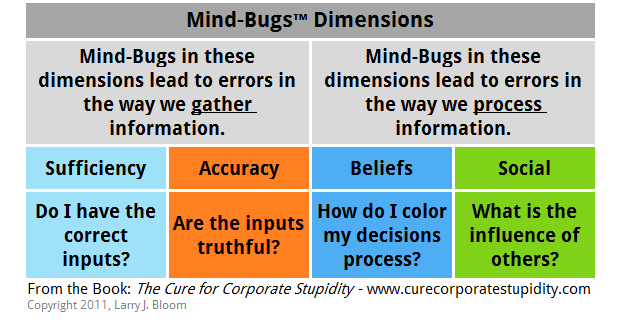THE MIND-BUGS
MEET THE MIND-BUGS

What exactly are Mind-Bugs? @:-D
Here is an excerpt from the book to help explain Mind-Bugs:
Left untrained, we all develop some poor habits of thinking. We are susceptible to making errors in judgment based on distortions in the way we perceive reality. We are all aware that our intuitions can be wrong, but there are cases when we find it difficult to abandon our judgments. Or conversely, we may find that our intuitions and judgments are influenced by unrecognized forces. For example, in business we often find this to be the case because we have specific results that we (or our boss, board of directors, or other stakeholders) desire and we attach strong feelings to achieving them.
The Mind-Bugs Taxonomy
Here is a figure from the book to explain how Mind-Bugs are organized:

Here is an excerpt from the book to explain the Mind-Bugs dimensions further:
Business decisions are generally based on verified information communicated from a point of view within a social context.
In general, Sufficiency and Accuracy are concerned with quality control of inputs, those pieces of information we use to make decisions. When we look for mind-bugs in these dimensions we are performing a quality control check that our inputs are both accurate and sufficient. Basically, these dimensions lead to errors in the way we gather information and address two questions: 1) Do I have the correct inputs? 2) Are the inputs truthful?
Beliefs address how we personally color the decision process with our own perspective, desires, values, and feelings. This dimension has to do with how we process information and answers the question “how do I color my decision process?”
Social considers the influence of other people, groups, power structure, bureaucracy, and vested interest. This dimension is also about how we process information and addresses “what is the influence of others?”
Introducing the Mind-Bugs Reference Chart
How to Use the Mind-Bugs Reference Chart
Here is one example of how to use the chart – an excerpt from the book explains how to discuss Mind-Bugs in a group:
Meet with a group of people with whom you are working to deliver results. Identify a specific result you are working to deliver together. Distribute individual copies of the Mind-Bug Reference Chart found in Chapter 14 and reproduced again here for your convenience. As it relates to the specific result:
1. Have each person identify the top three mind-bugs where each believes they are personally most vulnerable as it relates to this result.
2. Have each person identify the top three mind-bugs where each believes the group is most vulnerable.
3. Discuss the mind-bugs as a group.
4. Identify how the mind-bugs could cause problems.
5. Identify how to avoid problems and help decisions go right.
6. Have fun with the discussions.
What Now? Do Something!
> Read a summary of the book.
> Order the book now.
> Connect with the us on social networks.



